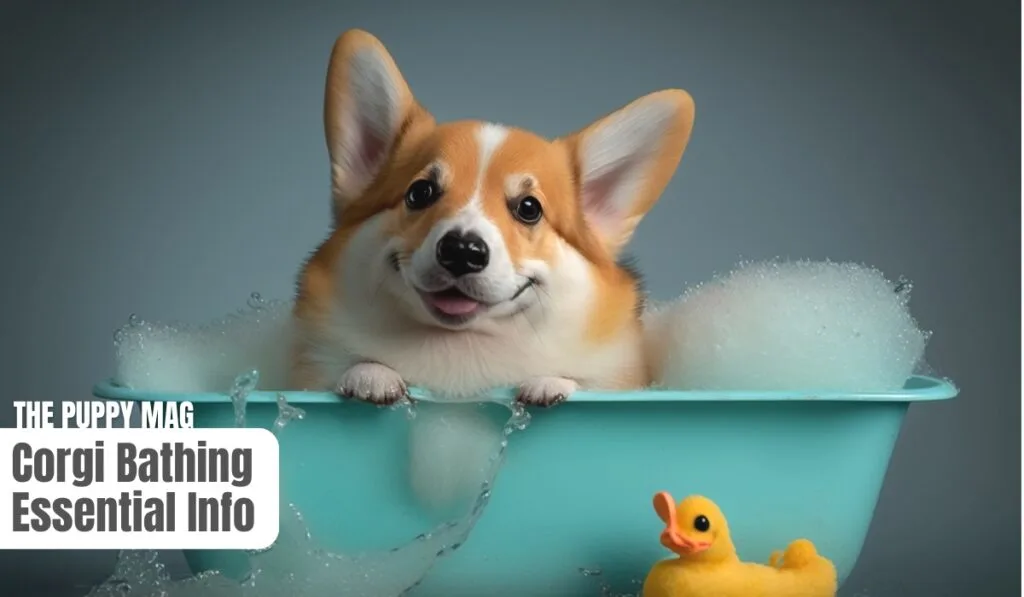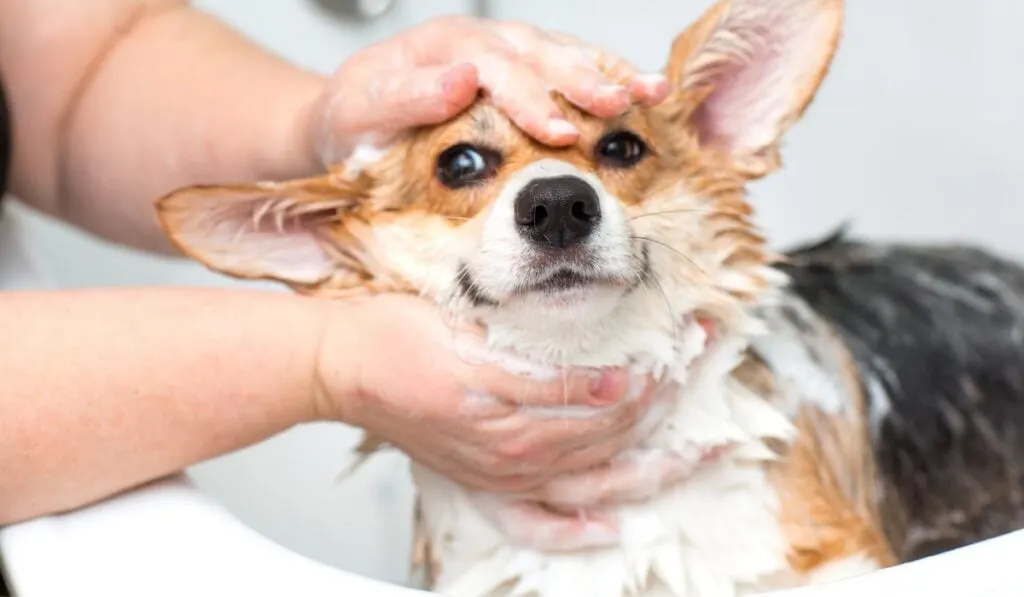When it comes to bathing your corgi, it’s important to get it right. It could mean the difference between a dull, greasy and smelly coat… Or a clean, smooth and soft coat!
Everything from bathing frequency, the shampoo to use, and how you bathe your corgi all matter. So this article we explain everything everything in full detail!
We’ve had everything approved by our resident veterinarian too!

Table of Contents
How Often To Bathe Your Corgi And Why
It’s best to bathe your corgi once every two months. This is enough to keep them clean without irritating or drying out their skin or coat.
The reason why it’s so crucial not to over-bathe your corgi is to avoid the risk of stripping away the essential oils found on her skin and throughout her coat.
These essential oils are responsible for keeping her skin and coat moisturized, healthy, and strong. Avoiding drying skin should be a top priority as it can lead to many problematic health conditions.
“Dry skin is the No.1 cause for dogs visiting the vets. Overbathing is one of the major contributors aside from allergies that lead to dry skin.”
The Importance Of Using a Natural Ingredient Shampoo
The shampoo you use is critical. The reason dry skin is so common in dogs is that the vast majority of regular dog shampoo contains harsh chemicals, detergents, alcohol, and parabens.
The purpose of these chemicals is to clean. But they do so in an unhealthy way…
They strip all of the natural healthy oils from your corgi’s coat and the grime and muck. Leaving the skin and coat exposed and dry.
It’s crucial to use only a natural-ingredient shampoo that avoids using chemicals, detergents, alcohol, and parabens. Natural shampoos do a better job of cleaning the coat without removing an excessive amount of healthy oils.
Fortunately, natural-ingredient shampoos are not any more expensive than regular shampoos. In fact, most regular shampoos have a higher price range because they are marketed more extensively.
- My favorite natural ingredient shampoo is from HoneyDew (Amazon).

What To Do When Your Corgi Gets Dirty All The Time
If you regularly walk your corgi in muddy areas, then you may be wondering how to keep her clean without overbathing.
First of all, when mud is dry, it typically brushes out with ease. Plus, if you already have a brushing routine of 2-4 times per week then this alone will do a very good job of keeping her clean.
- Slicker brushes do an amazing job of cleaning topcoats.
Aside from brushing, if your corgi gets too muddy, you can always rinse her off as many times as you like with lukewarm water.
If your corgi starts to smell, by all means, use shampoo in your next bathing session.
The whole idea of keeping shampoo to a minimum is to avoid drying out her coat. But If she starts to smell, don’t put off giving her a proper bath just because you’re trying to wait for the 2 months to come around.
Why we avoid the FURminator for Corgis
Important article: Can corgis be shaved or have haircuts?
How Do You Bathe a Corgi?
Let’s run through the best way to bathe your corgi. I will try to keep each step concise and straight to the point.
⭐ Where to bathe her: Keep her located in your bathtub, shower room, or if you bathe her outside, keep her on the leash tied up. This will give you control without her running away from you.
⭐ What you’ll need:
● Non-slip mat to avoid slipping and injuries
● Natural ingredient shampoo and conditioner
● Undercoat rake and slicker brush
● A couple of dry clean towels
⭐ What to do:
1) Brush her with an undercoat rake for 5 minutes to remove loose hair from the undercoat.
2) Wet her coat down thoroughly using lukewarm water. Avoid getting water in her ears!
3) Use a natural ingredient shampoo to work up a thick lather starting from the head. Use your fingertips to reach down to the skin and massage sufficiently throughout her entire coat. Be careful around the eyes and ears.
4) While covered in suds, use the undercoat rake for 5 minutes to pull out dead hair from the undercoat. Always brush going in the direction of her coat. Focus on brushing her body, neck, underbelly, and tail area.
5) After brushing, rinse her thoroughly for 5 minutes, ensuring she is shampoo-free.
6) Apply the conditioner as you did with the shampoo. Be sure to massage her coat and skin with the conditioner. Do this for 5-10 minutes to allow the conditioner to sufficiently soak in.
7) Rinse her again for a further 10 minutes. It’s absolutely vital to rinse all remaining suds from the coat.
⭐ Dry her properly: Use a clean towel to dry her as much as possible. Don’t let her run free until you have given her a thorough drying.
⭐ Keep her inside until fully dry: Keep her inside your home until she is completely dry. Don’t make the mistake of letting her run around in the yard prematurely. She’ll be enticed to roll around in the mud while she’s still wet which isn’t ideal. If she does it once dry, it will brush out easily.
⭐ Brush her again once dry: Once she is completely dry, be ready to give her a post-bath brushing. Giver her 10 minutes with an undercoat rake for the purpose of de-shedding, then finish off with a slicker brush to focus on her topcoat.
This is a simple routine but it will get you professional results!
Popular Read: When do corgis experience their first heat?
5 Bathing Tips For Corgis
Here are some extra bathing tips you may not have known to make each bath time safe and productive.
1. Use Peanut Butter to Keep Her Still
Peanut butter can be used as a handy treat to keep her still while you get to work. Peanut butter can be smeared lightly onto a dinner plate or even better, a tile wall (as it will wash right off). This will give you 10-15 minutes of freedom while your corgi is preoccupied.
Peanut butter has been deemed safe for dogs but it should not contain Xylitol or high salt. I advise reading this article first: PetMd Peanut Butter.
2. Talk To Her Throughout Bathing
Research has shown that dogs can interpret our tone of voice accurately to what we are trying to convey.
This can be used to your advantage if your corgi isn’t fond of bathtime. By talking to her in a reassuring voice, reminding her that she’s a “good girl”, she’ll feel more at ease while you bathe her.
By effectively using your voice, you’ll increase her confidence each time and before long she’ll be very receptive to all future bathing.
3. Only Use Lukewarm Water
Lukewarm is neither hot nor cold, and this is what you want to aim for when bathing your corgi.
I know it’s tempting to bathe her in warm water because we think it will be more comfortable. But the truth is that dogs are more sensitive to heat than we are, what we think is a nice warm temperature, may already be too hot for your corgi.
Also, warm or hot water will significantly increase the chance of drying out her skin afterward.
Please always stick to lukewarm water.
4. Don’t Forget To Brush Her Before, During and After
Brushing her at each stage will effectively remove the most amount of hair and make the overall bathing session more productive.
Brushing before will remove big clumps of already-dead hair just waiting to suck up valuable suds, there’s no point in leaving dead hair, so always brush her before.
While you are massaging in the shampoo, you will loosen up a lot of dead hair, so once again, give her a good brushing to remove it as you go.
Then finally, once she’s dry, another brush will bring out the remaining dead hair leftover from the bath.
Yup, it seems like a lot of brushing, but it’s not a daily occurrence. This is simply making the most out of the bathing session.
5. Massage Sufficiently
When applying the shampoo and conditioner, it’s important to properly massage the suds into her coat.
Use your fingers to reach down through the thick undercoat to her skin. By doing this you are making sure that the suds reach as far down as they should.
Some undercoats can be so thick that if you don’t do this, the shampoo or conditioner will never reach the lowest layers or her skin.
Popular Corgi Articles on The Puppy Mag
● Do Corgis Get Cold? Winter Safety Tips
● Why Your Corgi Isn’t Fluffy & What To About It!
● Corgi Shedding: Top Tips and Tricks
Corgi Bathing FAQ’s
Check out some of the most frequently asked questions regarding corgis and bathing below.
Can I bathe my corgi every month?
You could bathe your corgi every month, and many owners do. But it’s important to consider the risk of drying out your corgi’s skin and coat. Most corgis will not need bathing every month, and for the majority, bathing only once every two months is more than enough.
If I bathe my corgi infrequently will she smell?
Corgis have a moderate doggy odor, but in general, this breed is hygienic and rarely has a noticeable smell. If you keep on top of brushing which is important for the purpose of shedding, it will also keep her coat incredibly clean and odor-free as a bonus.
Should I bathe my corgi in winter?
If your corgi is due a bath in winter then it’s completely fine to do so. Of course, with the temperatures being very low, it’s essential that you prepare lukewarm water and keep her in a well-heated room until she is completely dry. You will also need to towel dry her thoroughly straight after the bath.
Can I use human shampoo?
Please avoid using human shampoo on your corgi. Human shampoo is naturally more acidic, which is fine for us, but it’s not for our dogs. Human shampoo could potentially ruin the acid mantle of your corgi’s skin. Stick to natural ingredient dog shampoo.
Can I use baby shampoo?
Yes, but only If you don’t have access to natural ingredient dog shampoo. Baby shampoo is mild enough to be safe for dogs. In fact baby shampoo would even be a better alternative over regular dog shampoo due to avoiding harsh chemicals.
Do I need to use a conditioner?
Yes, alongside an all-natural shampoo, you should also use an all-natural conditioner. The conditioner should be massaged in and left to soak for 5 minutes. Conditioner helps her skin and coat remain moisturized after bathing.
Thank you for reading! View more Corgi articles >>
